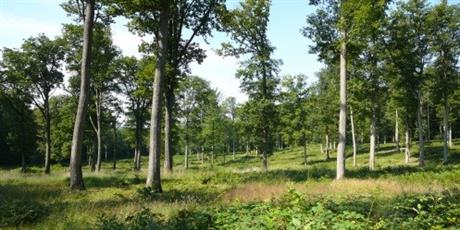Trees contribute greatly to our natural and cultural heritage. In addition to being ubiquitous in our most common landscapes, they also provide humans with invaluable services. In past and present human societies, their longevity and ability to withstand environmental changes made them important symbols in sacred, mystical and popular representations of stability, resistance and the perpetuity of life.
A reference genome for one of the 400 oak species
Scientists from the INRA and the CEA investigated the genetic bases of longevity of trees. They started their investigation by sequencing the genome of the pedunculate oak using high throughput sequencing technologies. This allowed them to sequence and assemble the 750 million nucleotides that make up the genome of this wide-spread European species, whose genetic diversity is ten times greater than that of humans.
A genome with an arsenal of defense genes against biotic threats, a likely key to longevity.

 Chênes de 150 ans de la Forêt domaniale de Bercé
Chênes de 150 ans de la Forêt domaniale de Bercé© Inra - Didier Bert
The annotation of the oak genome, which consisted of locating and determining the likely function of all genes (done by comparison with other species), showed that it is enriched with transposable elements (DNA sequences that move within the genome) at 51% of total DNA and contains 26,000 genes. Among these genes, 36% are organized in clusters of continuous genes (so called tandem duplicates); this number is much higher than found in other plants at ~15 %. The investigators also showed that the number of resistance genes in oaks increased mostly via tandem duplication. The comparison between the genomes of herbaceous species (Arabipdopsis, soybean, potato, watermelon…) and perennial woody species (oak, poplar, eucalyptus, peach tree…) demonstrates that this expansion of resistance genes is not specific to oaks, but shared among all tree species investigated. As trees remain living across years, they are continually barraged by pests; these pests likely evolve faster than their tree hosts due to their much shorter generation times. In these conditions the diversity and richness of immunity genes could help trees to cope with a broad range of short-lived microbial enemies and help them to persist and live longer.
Are trees genomic mosaics?
Multi-cellular organisms accumulate somatic mutations as they grow. The long life of trees, often reaching hundreds of years for some species, and their continuous growth across their lives makes them perfect models to investigate this phenomenon. The team investigated the frequency of somatic mutations by comparing the genomes of samples harvested at the extremities of branches of different ages on a centennial oak tree. This strategy allowed the researchers to identify rare somatic mutations, but also to show that they can be transmitted to the next generation. The next step will be to determine the importance of this mechanism in generating genetic diversity in populations and whether some of these mutations can confer individuals with a selective edge.
Although we know that colonization of European white oaks after the last glacial maximum (18,000 years ago) was massive, in such a way that it rapidly reached its current distribution range, the reconstruction of evolutionary trajectories of oaks remains largely unknown. The successful set up of a method to extract DNA from semi-fossilized wood, combined with the use of the oak reference genome, will probably help us to reconstruct the evolutionary history of oaks with unparalleled precision.